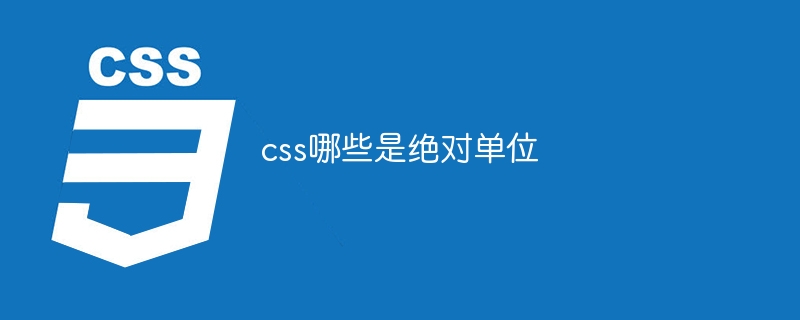
Absolute units in CSS include pixels, inches, centimeters, millimeters, and points. Detailed introduction: 1. Pixel is the most commonly used absolute unit. It represents a point on the screen. Pixels are fixed and will not change according to the screen size. In CSS, pixels are usually used to specify the size, spacing, and border of elements. and other attributes; 2. Inch is a physical unit, indicating that 1 inch is equal to 2.54 centimeters. In CSS, you can use inches as the size unit to specify the size of elements; 3. Centimeter is a physical unit, indicating that 1 centimeter is equal to 0.3937 inches, etc. .

The operating system for this tutorial: Windows 10 system, DELL G3 computer.
In CSS, there are some units of measurement called absolute units, and their values remain fixed across different devices and environments. These absolute units do not change when screen size or browser settings change. The following are common absolute units in CSS:
1. Pixel (Pixel, px): Pixel is the most commonly used absolute unit, which represents a point on the screen. Pixels are fixed and do not change based on screen size. In CSS, pixels are often used to specify attributes such as size, spacing, and borders of elements. For example, width: 200px; means that the width of the element is 200 pixels.
2. Inch (in): Inch is a physical unit, indicating that 1 inch is equal to 2.54 centimeters. In CSS, you can specify the size of an element using inches as the unit of size. For example, width: 2in; means the element is 2 inches wide.
3. Centimeter (cm): Centimeter is a physical unit, indicating that 1 centimeter is equal to 0.3937 inches. In CSS, you can specify the size of an element using centimeters as the unit of size. For example, width: 5cm; means that the width of the element is 5 cm.
4. Millimeter (mm): Millimeter is a physical unit, indicating that 1 millimeter is equal to 0.03937 inches. In CSS, you can specify the size of an element using millimeters as the unit of size. For example, width: 50mm; means that the width of the element is 50 mm.
5. Point (pt): Point is a physical unit, indicating that 1 point is equal to 1/72 inch. In CSS, you can specify the size of an element using points as the unit of size. For example, font-size: 12pt; means the font size is 12 points.
These absolute units maintain consistent dimensions across devices and screens because they are not affected by screen resolution or browser settings. Relative to other units, the pixel is the most commonly used absolute unit because it has a fixed size and provides precise control in most situations.
It should be noted that when using absolute units, the differences between different devices and screens should be taken into account. Due to the different pixel densities of different devices and screens, the same pixel value may appear at different physical sizes on different devices. Therefore, when designing responsive pages, other units (such as relative units) should be combined to achieve better adaptability.
To summarize, absolute units in CSS include pixels (px), inches (in), centimeters (cm), millimeters (mm), and points (pt). The values of these units remain fixed across devices and environments, and can be used to specify properties such as dimensions, spacing, borders, etc. of elements. When using absolute units, you need to take into account the differences between different devices and screens to ensure the consistency and adaptability of the page on different devices.
The above is the detailed content of What are the absolute units in css?. For more information, please follow other related articles on the PHP Chinese website!